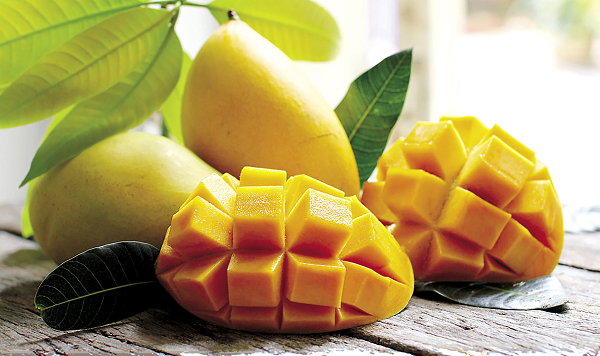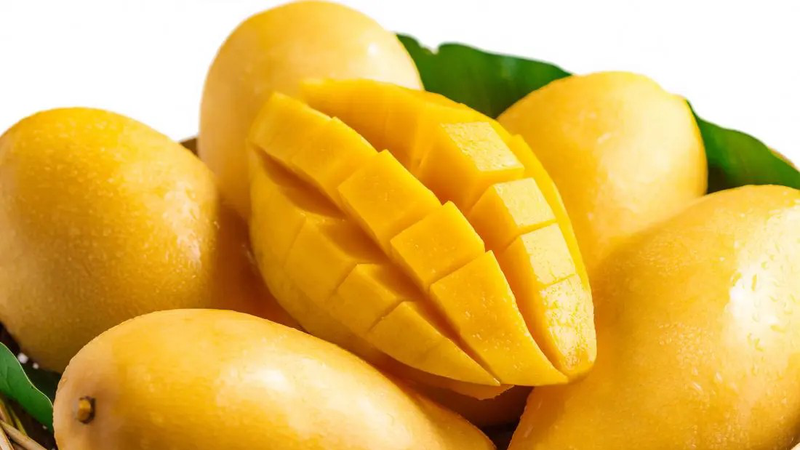
Vietnamese Mango is one of the most widely grown and beloved tropical fruits in Vietnam. With ideal climatic conditions, especially in the Mekong Delta (ĐBSCL) region, Vietnam has cultivated a diverse collection of mangoes, ranging from treasured traditional specialties to high-quality imported varieties, catering to diverse tastes and meeting export demands.
1. Specialty Mango Varieties that Define the Vietnamese Brand
Vietnam proudly possesses several famous mango varieties that are sought after both domestically and in international markets:
| Mango Variety | Prominent Growing Region | Characteristics when Ripe | Distinctive Value |
| Cát Hòa Lộc Mango | Tiền Giang (Hòa Lộc), Bến Tre | Elongated fruit, pale yellow skin, golden flesh, super smooth, minimal fiber, intensely sweet flavor and rich aroma. | Nicknamed the “Queen of Mangoes,” highest value, highly favored in Japan and South Korea. |
| Cát Chu Mango | Đồng Tháp (Cao Lãnh) | Smaller than Hòa Lộc, slender shape, bright yellow skin, soft and chewy flesh, low fiber, delicate sweetness, captivating aroma. | Top export quality, appreciated for its texture and characteristic fragrance. |
| Keo Mango | Cambodia/An Giang, Southern provinces | Green fruit, rounded middle. Usually consumed green (unripe) for its characteristic crunchiness and light tartness. | Popular for street snacks (shaken mango, salad), crunchy, less sweet when green. |
| Tứ Quý Mango | Mekong Delta | Large fruit ($1.5$ – $2$kg/fruit), harvested nearly year-round, firm flesh, crunchy-sweet, low fiber. | Impressively large size, high yield, suitable for bulk consumption. |
2. Successful Foreign and High-Potential Varieties
In addition to indigenous varieties, Vietnam has successfully propagated several imported mango varieties, further diversifying the product range:
- Australian Mango (Kensington Pride):
- Characteristics: Round fruit, skin turns a beautiful blush of red/pink when ripe, firm flesh, crunchy-sweet, mild aroma.
- Value: Visually appealing, attracting high-end consumer markets. Widely grown in Khánh Hòa.
- Taiwanese Mango (Taiwan Mango):
- Characteristics: Large fruit ($1$ – $1.2$kg), skin can be green, yellow, or red, produces fruit year-round. Thick flesh, refreshing sweetness.
- Value: High yield, meets stable demand for processing and export.

3. The Export Advantage of Vietnamese Mangoes
Vietnam’s mango industry is continuously growing in the global market, particularly in China (where it holds a dominant market share), the United States, Japan, and South Korea, due to:
- Superior Quality: Varieties like Cát Hòa Lộc and Cát Chu are highly regarded for their flavor, deep sweetness, and smooth flesh texture (low fiber), often surpassing mangoes from many other countries.
- International Standards: Large growing areas (such as Đồng Tháp) strictly apply VietGAP and GlobalGAP standards, ensuring food safety and clear traceability.
- Product Diversity: Besides fresh mangoes, Vietnam also exports value-added products like soft dried mangoes, frozen mangoes, and mango powder, which increase value and shelf life.
4. Nutritional Value
Mangoes are not only delicious but also an excellent source of nutrition:
- Vitamin C: Helps boost the immune system.
- Vitamin A & Beta-Carotene: Excellent for eye and skin health.
- Fiber and Enzymes: Aids digestion and prevents constipation.
- Glutamic Acid: Supports brain function and improves memory.
Vietnamese Mangoes are more than just a fruit; they are a source of pride for tropical agriculture, offering diverse choices, high quality, and outstanding nutritional value to consumers worldwide.
Other articles:
Other agricultural products:

